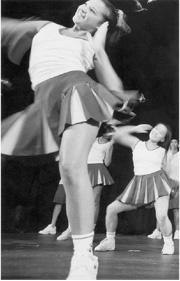The most memorable item in this year’s Pacific Northwest Annual isn’t a painting, photograph, or sculpture. It’s a dress. It’s made out of a thick, resilient material that’s cut in a style from the last century, with a tight, buttoned-up bustier and a long, fluid skirt. Titled En Carne Viva, this beautiful piece of clothing looks like a genuine artifact from another era. It’s easy to imagine an owner who wore the dress, was admired in it, and treasured it enough to preserve it for the ages.
Pacific Northwest Annual
Bellevue Art Museum, till August 16
The true story of the dress is that it’s made from hogs’ guts. Patricia Cutts, who works at Western Washington University, frequented a butcher to collect intestines, which she then stretched, sewed, and coated with resin. The resulting texture-rich “fabric” is tinged with a slightly yellow cast, like aged damask. Displayed in a dark nook of the museum, En Carne Viva glows like a specter, illuminated from within by a single light bulb.
For the past seven years, the Bellevue Art Museum has held an open call for entries for its Pacific Northwest Annual. It’s a chance for any artist, known or unknown, working in any medium, living in Washington, Oregon, or Idaho, to display their work. Being the free-for-all show that it is, an exhibit like this can compromise theme in favor of exposure. Each artist gets to show one or two pieces, and the overall exhibit seems struck with a multiple-personality disorder—too many artists, too many moods.
Senior curator Brian Wallace, who was hired by the museum at the beginning of this year, has tried to trim down the usual jumble. He’s been more selective than past curators. Out of 650 applicants, he chose only 35, less than a third of the usual number. It’s a bold move by the new curator, but it could have been bolder.
Memorable pieces included Paul Slipper’s Overstuffed, a granite and marble sculpture that rocks our traditional expectations of the medium. A hunk of granite is treated like expandable cloth, “closed” with white marble zippers at each side.
M.K. Guth’s deceptive wall installations appear, at first glance, to be made of rattan or wicker. From a few feet away, the viewer sees only color and overall texture, dark brown, scratchy, almost pretty. But the pieces are actually composed of thousands of bees, lined up and laid on their stomachs, with heads and legs stuck on plates of wax and resin. This is a work of meticulous obsession that is quietly horrific.
Photographs by Christopher Harris play up the viewer’s fascination with minutiae in an updated riff on a famous Edwardian hoax: pictures of fairies. Using a home-made panoramic pinhole camera made from cardboard, disposable pie tins, a bleach bottle, and plastic tape, Harris photographs people in a garden, letting the camera’s multiple apertures overlap images and alter perspective. Flowers, grass, and garden hoses loom huge in black and white, while Harris’ wife, sons, and parents are diminished to the size of insects.
It would have been nice to see more examples from these and a few other artists, even if it meant excluding a larger part of the group. Kait Rhoads’ glasswork, for example, which was exhibited earlier this year at the William Traver Gallery, gets an unsatisfying show here. The selected piece, Sugar Shack, is not her strongest work. Nor does it represent the eerie beauty she can create with her luminescent, beehive-like sculptures, or with her large-scale structures of long, bamboo-like glass rods.
What could have been edited out: The wall-hogging installations by D’Arcy McGrath and Willem Volkersz, whose works seem juvenile and kitschy, respectively, and Kathleen Shannon’s photographs of “Lost Cat” posters. Shannon’s idea of focusing on something we normally ignore wasn’t terribly original to begin with, and her execution — marred by large dark spaces and lack of focus—did nothing to reinvigorate it.






